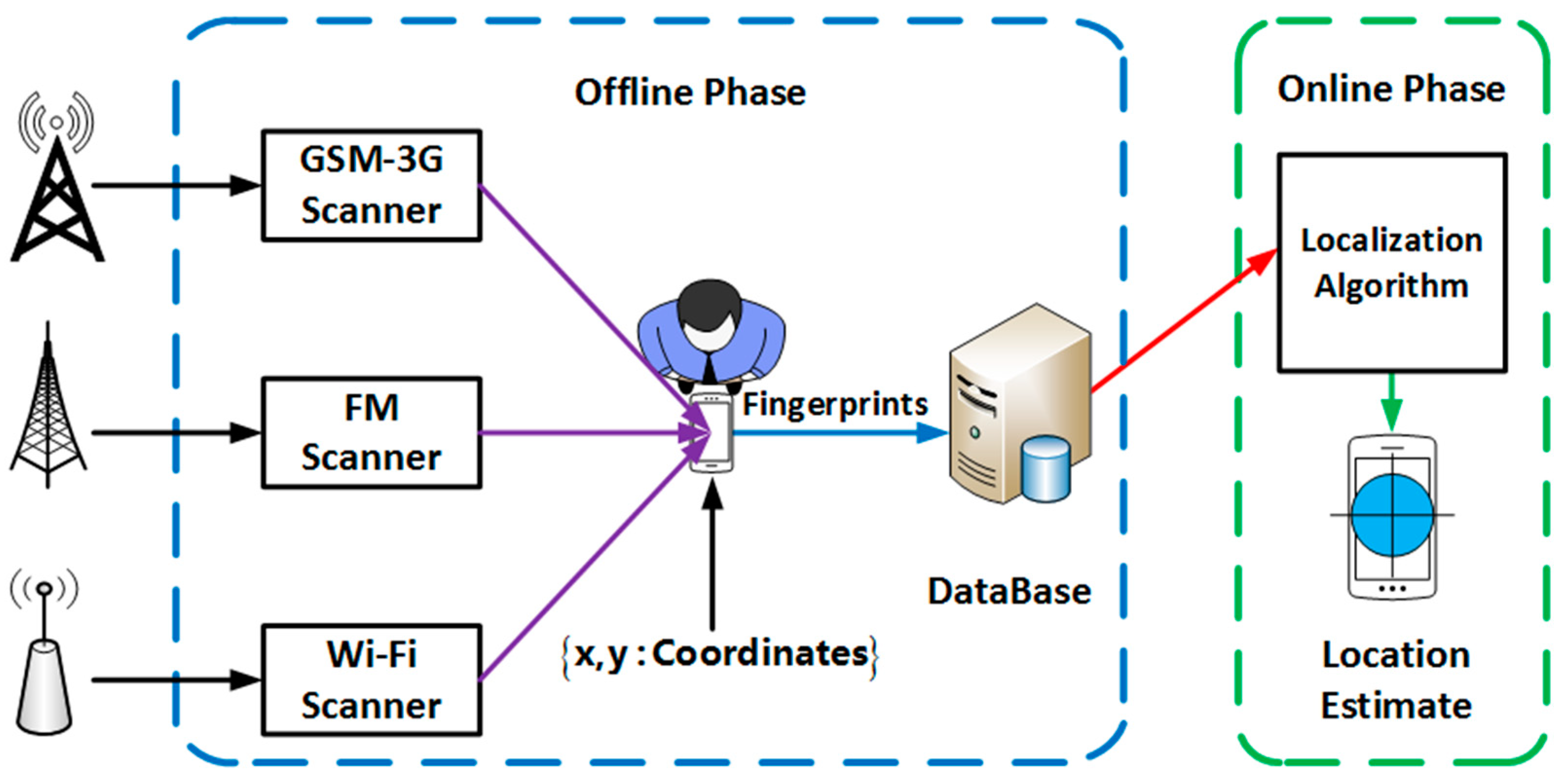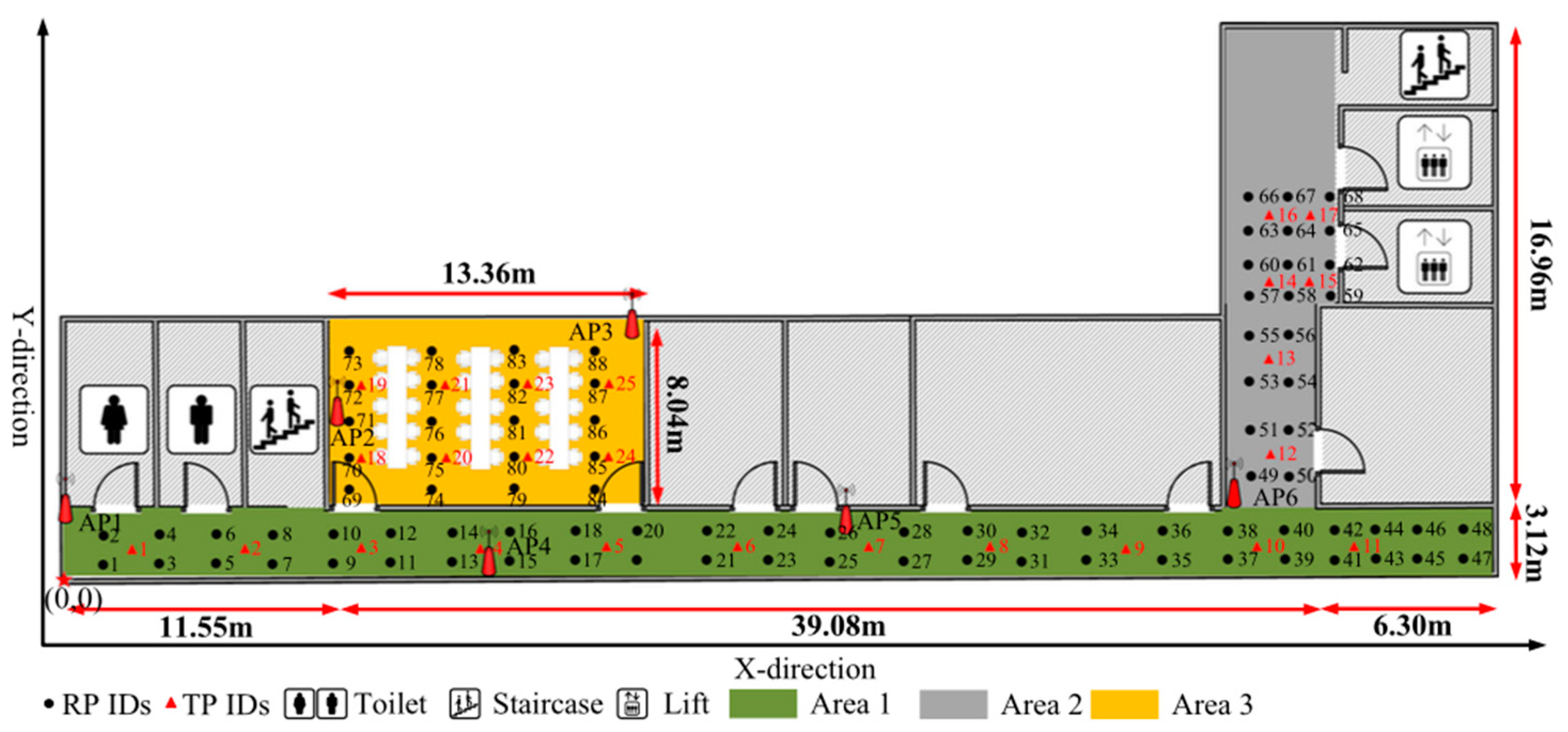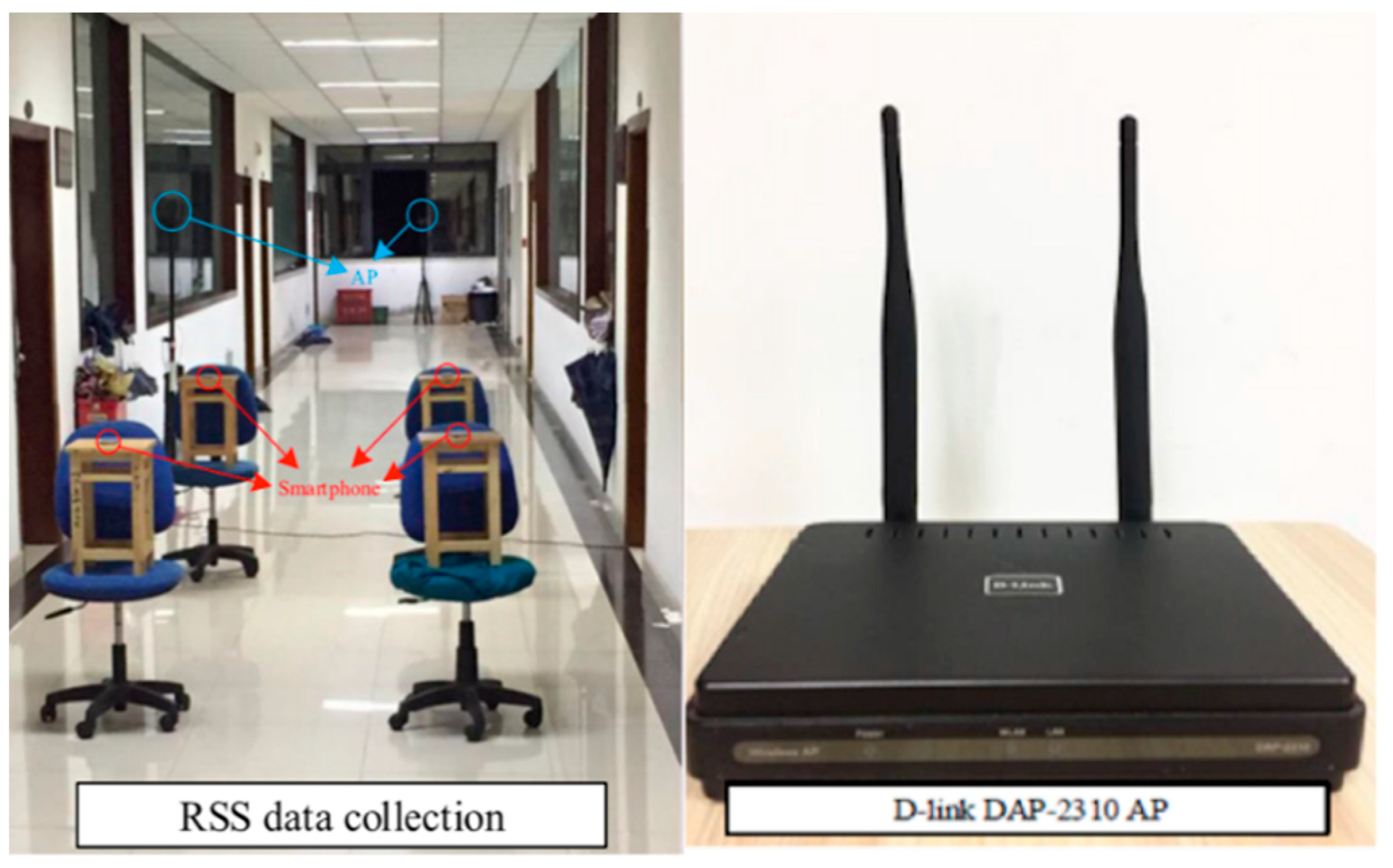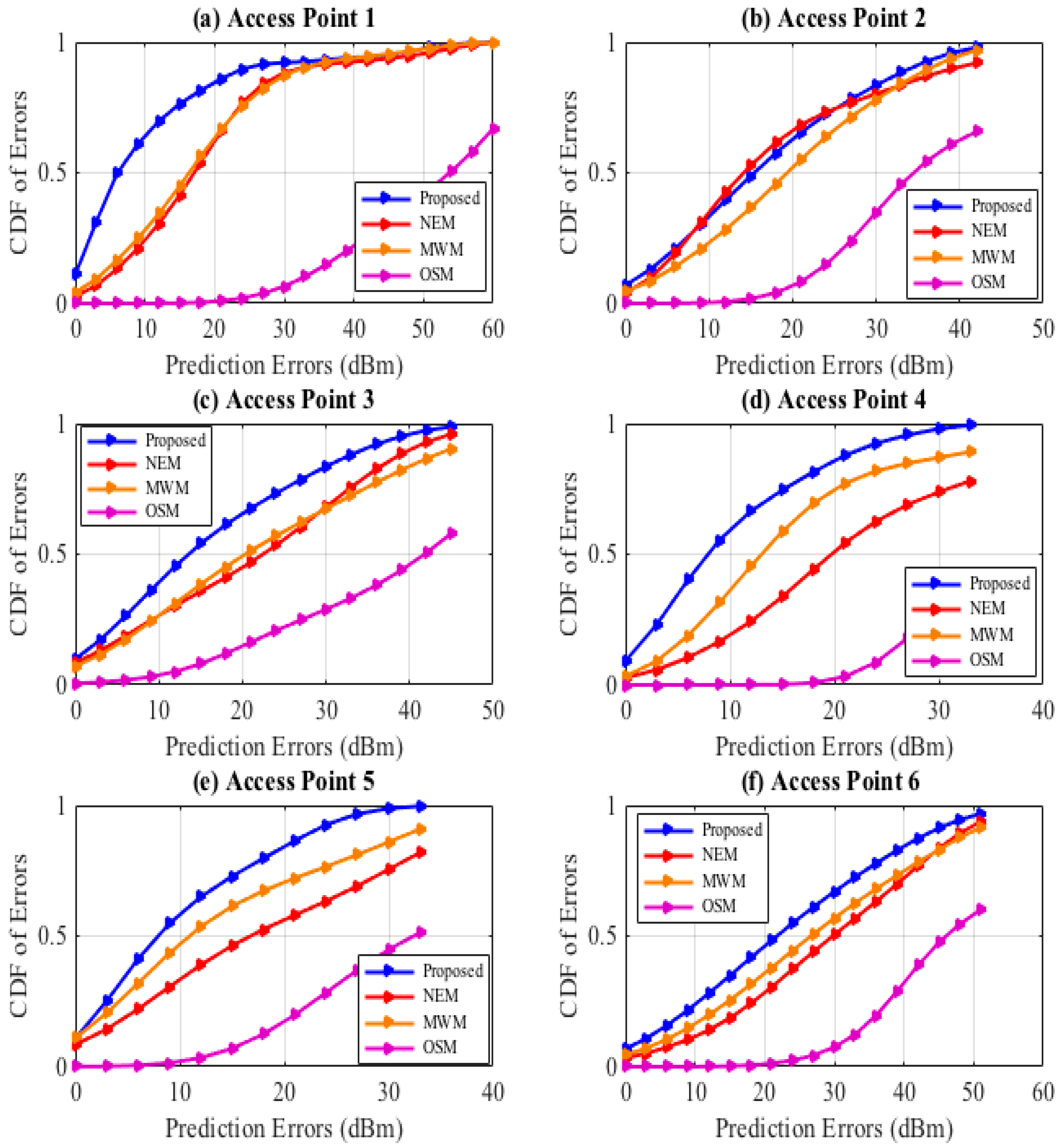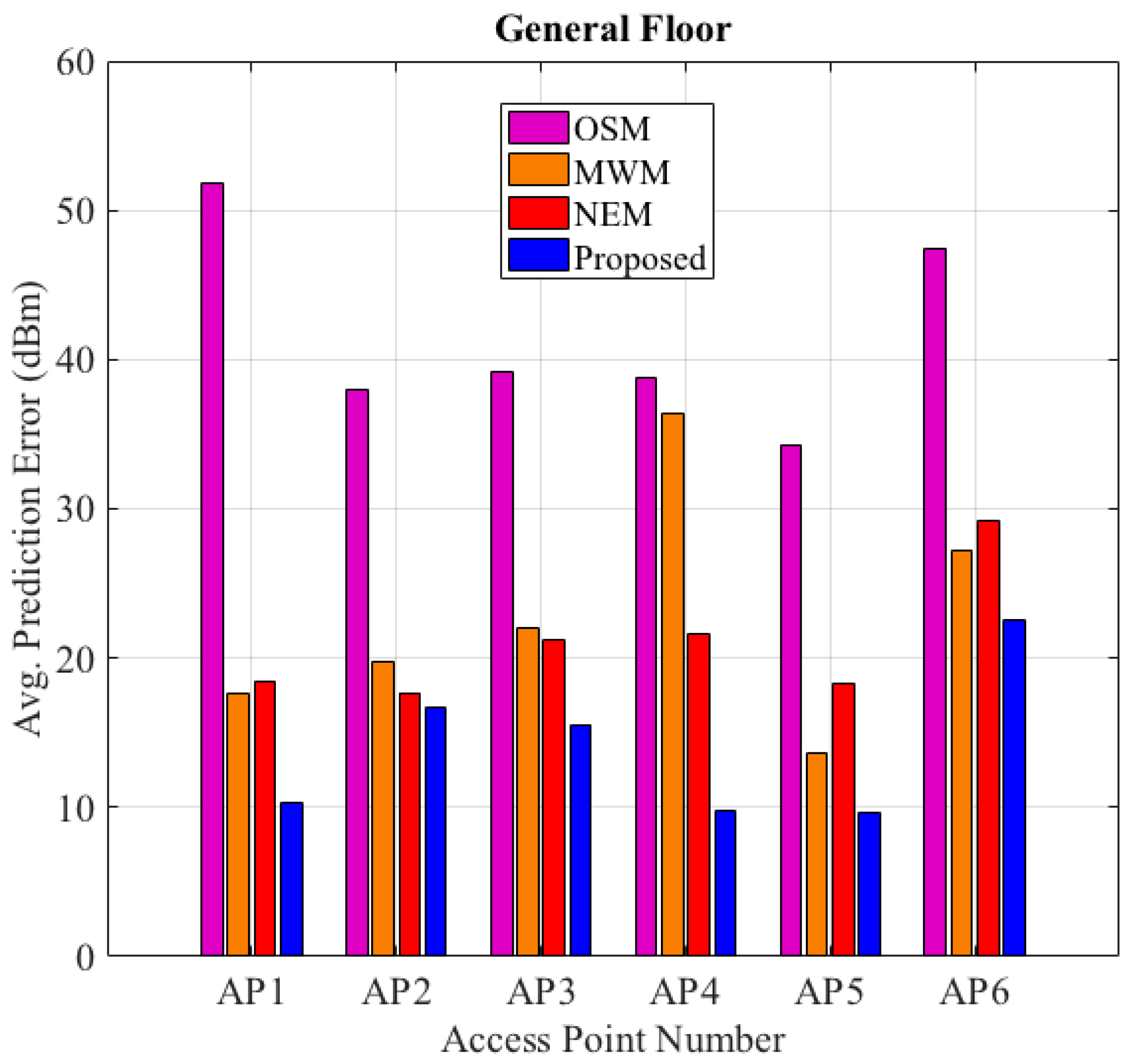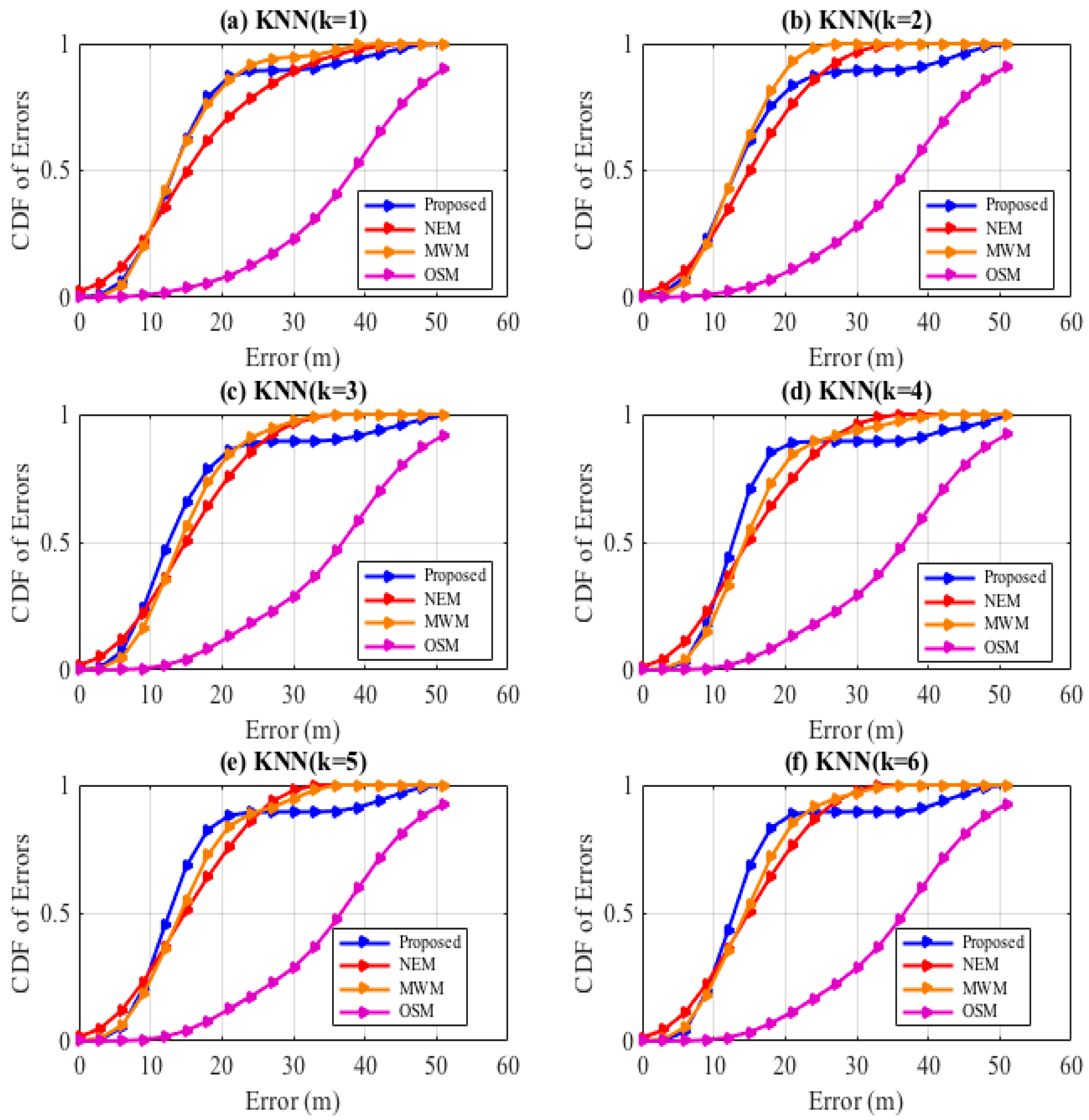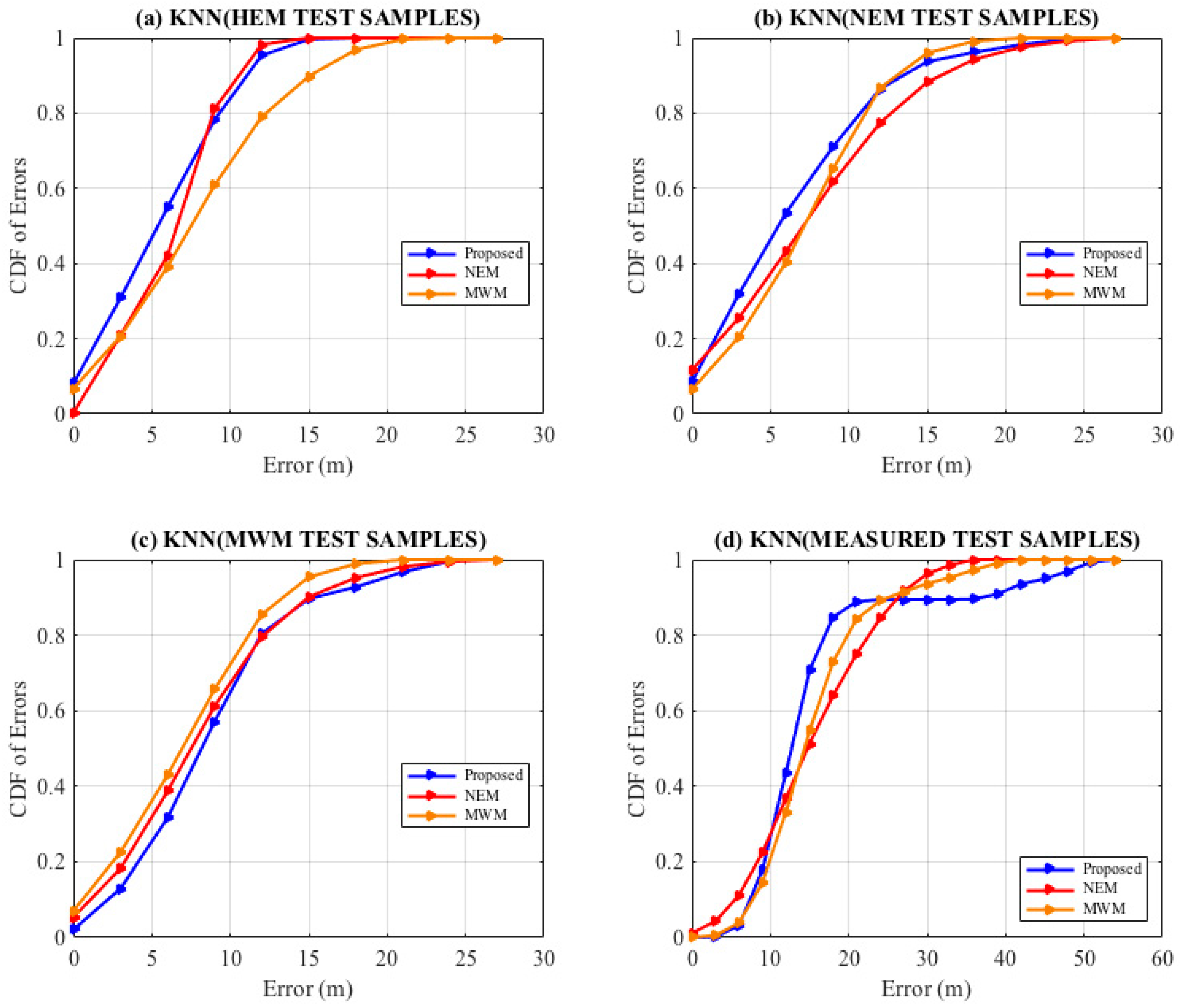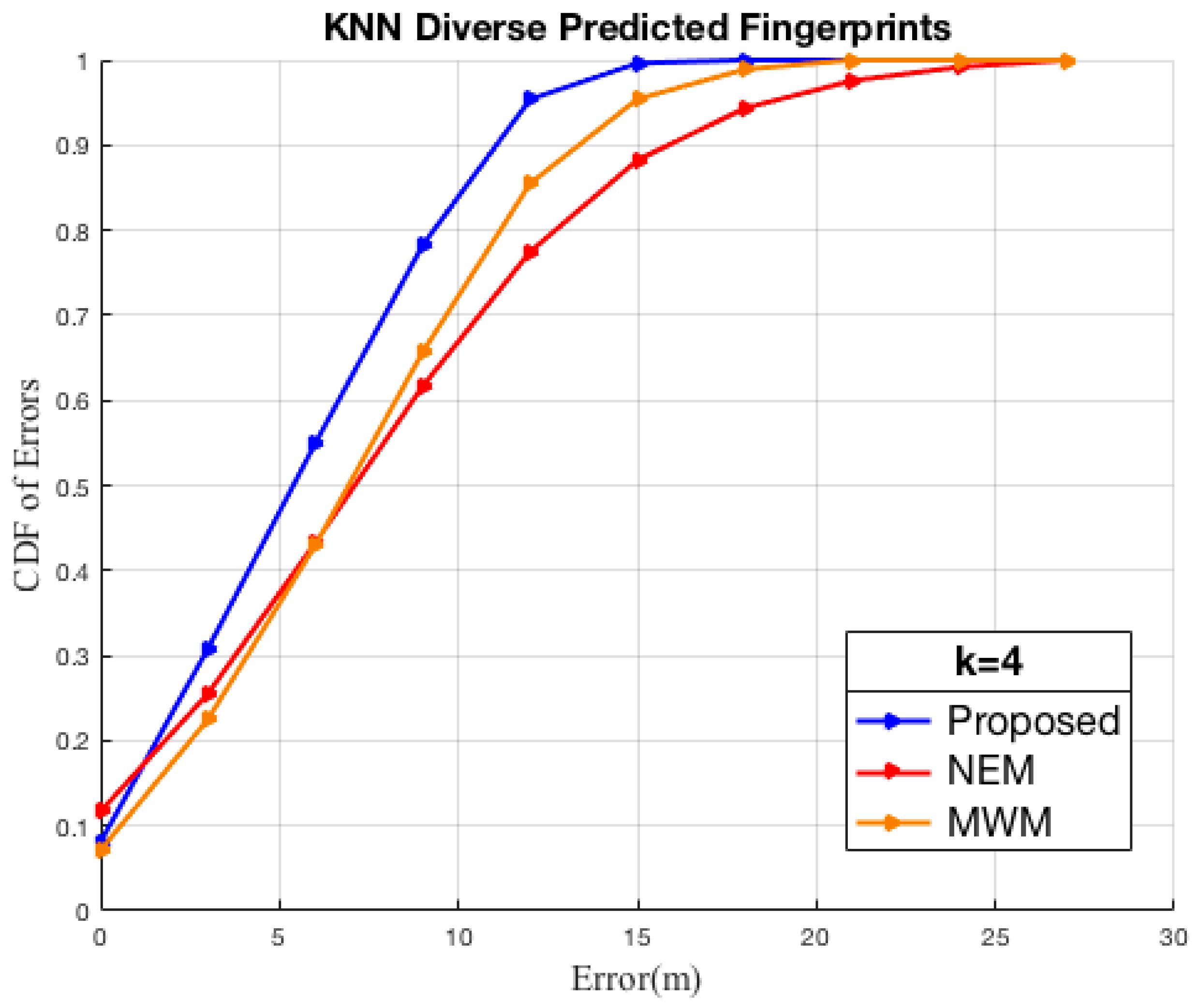1. Introduction
Wireless communication in recent years has seen a gradual growth of reliance on services-based localization, justified by Artificial Intelligence optimization algorithms [
1,
2], opening up huge prospects. Even though outdoor Global Navigation Satellite Systems (GNNS) such as the Global Positioning System (GPS) [
3,
4], BeiDou (BDS) [
5], Global’nalya Navigastsionnaya Sputnikovaya Sistema (GLONASS) [
6], have been applied in outdoors scenarios, they render inadequate assistance within a complex in indoor environments [
7], attributed to the complexity of indoor environment [
8], due to multipath interference, shadowing, dynamic environmental changes due to observed variation effects of different materials inside the building on the dissemination of signal and the need for higher accuracy at a lower cost and no extra hardware support [
9]. The widespread use of sensors, smartphones, and the mobile Internet has allowed precise mobile positioning [
10]. A milestone in the realization of the Internet of Things (IoT) has seen a vast increase in the deployment and application of smart indoor environments that dramatically drive the Location-Based Services (LBS) concept, ranging from increased social networking to health applications such as healthy aging monitoring, personal tracking, enhanced 911 (E911) emergency response indoor route analysis, inventory control, wall through intruder detection, drone tracking and robotics, peer file sharing and printing applications, in-airport passage assisted navigation [
11] and several other indoor location-aware applications proportionally contributed to the research objectives and motivation, without forgetting location side-information that can enable environment aware communication network design, operations, and optimization in high radio spectrum of the 5G new radio and the 6G networks [
12,
13,
14,
15]. The key enablers can be attributed to new frequencies, the development of Artificial Intelligence (AI), and Machine Learning (ML) techniques over the years.
Research has considered specific sensors and emitters installed inside a target indoor space to localize user equipment and objects. It is not scalable and includes a specific overhead cost to install and maintain the extra infrastructure. Different technologies such as ultra-wideband [
16], Bluetooth [
17,
18], Radio Frequency Identification (RFID) [
19], Micro-electro-mechanical (MEMS) [
20], magnetic field [
21], ultrasonic [
22], computer vision [
23], infrared signal [
24] and other’s utilize existing infrastructure such as the WLAN [
25], that considers wireless RSSI to localize the user equipment, RSSI values readings are widely and freely available in most mobile devices of this IoT era, not forgetting the availability in the most popular operation system such as the android and the Microsoft windows [
26,
27]. This approach normally needs comprehensive pre-surveying and training efforts to establish radio frequency (RF) characteristics of the complex indoor environment.
Measuring the distance between the unknown node and beacons is an essential part of the positioning process within indoor environments. Most of the existing UE localization algorithms used nowadays can be divided into two categories depending on whether distance measurements are required or not. One of these categories is the range-free measurement localization algorithm, and the other is the range-based measurement localization algorithm [
28]. The distance measurement algorithm calculates the distance between the known beacon node and the unknown node connected to it, utilizing their communication link parameters. The main categories of distance measurement algorithms are the Angle of Arrival (AOA) based algorithm [
29,
30], Time of Arrival (TOA) based algorithm, and Time-Difference of Arrival (TDOA) based algorithm [
31,
32,
33]. The TOA and TDOA require synchronization and accurate timing for components, thus, increasing the complexity of the system, and AOA for localization will require realistic antenna arrays that require high energy consumption, cost, time, additional hardware, and the RSSI based-algorithm [
34,
35,
36,
37,
38,
39]. Keeping in mind that each of these considerably increases the cost of the positioning system, thus, the proposed HEM indoor technique is based on RSSI prediction and distance measurement.
Indoor radio propagation environment has in the past and currently been perceived as a random component of advancing wireless communication systems, which has led researchers to introduce Intelligent Reflective Surfaces (IRSSI) as a promising solution to control scattering, reflection and refraction by allowing dynamic shaping and control of the electromagnetic waves responses of the environmental objects through the phase, amplitude, frequency and polarization parameters [
40] IRSSI could enable tracking/surveillance application in Non-Line of Sight (NLOS) communications and autonomous localization. Amongst the breakthroughs, utilization of the RSSI-based localization approach, such as fingerprinting, has been adopted for location estimation and wireless coverage estimation methods [
41,
42,
43,
44,
45]. In [
46], a fingerprint-based positioning algorithm is proposed by collecting RSSI samples into the fingerprint database. In [
47], the authors have executed and analyzed several positioning algorithms such as centroid localization, proximity localization based on RSSI, fingerprinting, and trilateration localization, conclusive that the fingerprinting positioning algorithm is the most fitting one. Fingerprint positioning methodologies require a large amount of a priori information support, which adds a high–cost issue. Moreover, suffering from multipath effects and electromagnetic interference due to different types of materials have a significant impact on wave propagation and as a function of the frequency in complex indoor environments. Such an approach considers two phases, the offline phase, and the online phase. During the off-line calibration phase, the target indoor environment is calibrated with the help of a pre-site survey to predetermine grid reference points at which time-stamped sampled signal values as fingerprints from various transceivers are recorded and stored in a database commonly known as the “radio map.” The online phase, commonly known as the “Localization” phase, will deploy various algorithmic approaches to effectively match the stored radio map values to find the best match, whose location is presented as the localization result. This approach’s drawback relates to the size of the database when handling a large number of observations and the time spent. The mode for the indoor propagation channel has a significant impact on RSSI value, which shows variability with changing locations [
48]. This variability is based on many effects of the separation distances, the geometrical, different materials used, and the movement of the objects. Additionally, multipath and shadow fading have a great effect on RSSI values [
49]. In contrast, RSSI-based location estimation is significantly affected by the position of the AP and the position of received points. Several researchers have proposed AP location estimation using neural networks [
50] as well as studying the effect of transmitter placement in the wireless sensor network and Line of Sight (LOS) investigation of different AP heights on RSSI measurement variation as in [
51]. These proposed methods have not leveraged the indoor Fresnel ranging coverage of interest based on transceiver height in LOS and NLOS in a multi-wall indoor environment to improve the path–loss RSSI prediction model that, in turn, reduces the cost of the RSSI fingerprinting.
This paper proposes a novel indoor positioning technique based on a new RSSI distance prediction HEM model that leverages the transceiver height, the signal wavelength, and its assumed Fresnel coverage of interest on the target floor. The proposed technique based on a novel method for RSSI prediction improves both the estimation and localization accuracy for complex indoor environments at a low cost of fingerprinting since no additional hardware is required. Our proposed method is experimentally tested and verified in an indoor laboratory environment and a corridor using six WLAN APs. In addition, real RSSI data measurement was collected using our developed android application (APP), and data were processed for conventional assessment of the performance of the proposed methodology. In this paper, our contributions may be summarized in the following parts:
Novel transceiver height and signal wavelength dependence on RSSI path–loss model prediction are proposed. A large number of RSSI samples are predicted, and each RSSI sample is formulated into fingerprints quickly. Reducing the complexity and technical know-how required for offline conventional fingerprinting.
We propose an indoor radio fingerprint-based approach to the calculation of the value of k as in the number of nearest neighbors for the K-Nearest Neighbors algorithm leveraging the surface area of the target space to the number of sampling points.
The organization of this paper is as follows.
Section 2 presents related works on the propagation models for fingerprint architectures. In
Section 3, the presentation of the proposed transceiver height dependence model (HEM), data collection, Wi-Fi signal acquisition setup, model prediction setup, and prediction accuracy discussion.
Section 4 presents the Localization evaluation of the proposed fingerprint toward existing approaches. The final remarks are presented in
Section 5.
3. Proposed Transceiver Height Dependence Model (HEM)
Indoor environments have continued to be more complex and challenging, attributed to interior design finishes, space demarcating, and occupancy. Thus offline RSSI estimation from the transceivers using models is affected by several factors not limited to the multi-path effects (reflection, refraction, and absorption). Considering online localization techniques based on RSSI distance prediction using the RSSI log-distance distribution model is challenging because severe RSSI fluctuation occurs, especially in a complex indoor environment. In our study, we propose a new RSSI prediction technique that leverages the transceiver height into the formulation of the prediction model, which in turn minimizes the prediction error as well as localization error. Determination of the electromagnetic field region around a vertically installed dipole antenna, regions such as the reactive near-field region, radiating near-field region, also known as the Fresnel region, and the far field region (Fraunhofer) is a more challenging task within indoor space than related studies for outdoor scenarios. For example, considering a vertical monopole in a complex indoor space, such as an AP transceiver working at a height
of 2.4 GHz, we propose to define the breakpoint distance dependent leveraging the transceiver height and wavelength of the signal as defined in Equation (6).
where
is the proposed breakpoint distance ranging region,
is the maximum dimension of the antenna,
is the wavelength of the transmitted signal by the antenna, which is further derived as a fraction of the speed of light
to the frequency of the transmitted signal
as defined in Equation (7). Considering Equation (6) into Equation (7) leads to the newly proposed novel path loss is denoted as:
3.1. RSSI Data Collection
All the experimental tests are performed at a faculty-building floor of the School of communication and information engineering, Chongqing University of Posts and Telecommunications (CQUPT). A cubic meters floor of the west wing, as shown in
Figure 2, was considered for the experimental data fingerprinting benchmark to verify the extent to which our newly proposed HEM model, as defined in Equation (8), has applicable results in the current drive for smart IoT location-based communication. The test bed of 56.93 m × 20.08 m is comprised of rooms, corridors, offices, and washrooms with diverse floor and ceiling finishes, a typical indoor environment, during the daytime to idealize the impact of occupancy in the environment. Starting from the left side of the test bed as the origin marked in red color
, we carried out the tiresome calibration of the site to obtain 88 RP locations spaced at 0.6 m apart in the two corridor areas, as areas 1 and area 2 before the lifts, respectively, and in the research lab as area 3, thus, dividing the space into three areas. As shown in
Figure 2, the black circle and the red triangle represents the reference points (RP’s), and the test points (TP’s), respectively. In general, they are comprised of 48 RPs and 11 TPs in area 1, 20 RPs and 6 TPs in area 2, and 20 RPs and 8 TP in area 3, with a total of 6 D-Link DAP-2310 Aps with known Mac addresses as shown in
Table 1, arranged in the target environment at a height (h) of 1.89 m. A realistic environment was considered, with occupants on the floor, some walking randomly and others while working on their tables.
3.2. Wi-Fi Signal Acquisition
The actual sampling acquisition of RSSIs in the experimental environment using our developed Wi-Fi signal data acquisition software comprises the process of collecting RSSI samples of each DAP-2310 AP using the Samsung S7568 mobile phone terminal setup at the level of the pedestrian arm length height as shown in
Figure 3 and
Figure 4, respectively.
Our developed Wi-Fi signal data acquisition software interface is simple and user-friendly, composed of the RP name and the time interval at which we sample the RSSI (in dBm) in a convenient way and preprocess the raw data, as shown in
Figure 4a. On initiating the process, as illustrated in
Figure 4b for a predefined time stamp, it records the sampling time interval, the RSSI recording, followed by the MAC address of the transceiver AP as shown in
Table 2. The Samsung S7568 mobile phone has a Wi-Fi signal acquisition frequency of 1 Hz, thus, enabling us to first collect RSSI samples from 6 APs at each respective RP for a duration interval of 60 s (that is, the RSSI sample of an AP at each RP contains 60 RSSI values). Similarly, in the same faith, at each TP, the same Samsung S7568 smartphone is used to collect RSSI data samples from 6 APs for 20 s (that is, the RSSI sample from a certain AP at each test point contains 20 RSSI values). The data is then saved in the Security Digital card (SD) as a txt. format to be processed using MATLAB R2013a as a programming tool to construct the location fingerprint Database to achieve the proposed methodology of this article.
Letting
be the number of RPs and
the total number of APs deployed in the signal coverage target floor. We denote the RSSI value from AP
at RP
as
. We sample multiple random fingerprint signals at each predefined RP, then average the signal values to find the mean RSSI
at each RP
from AP
denoted as
where
is the
RSSI sample (in dBm) at RP
from AP
, and
is the total number of RSSI samples collected within the predefined time stamp. Then the fingerprint at RP
is defined as
Forming an interactive radio map database matrix as
where
when the
AP is not detected, however, in some cases, we convert it to −90 dBm as the signal noise floor within an indoor environment.
Online localization exploits the pre-constructed database to determine the current location
given the
test RSSI sequence denoted as
where
is the total number of received test RSSI sequences from
AP at the
unknown test RP
. Taking into consideration each test fingerprint as
we define the test localization radio map as
by
where
is the averaged recorded test RSSI sequence from the
AP at the
unknown test RP,
is the total number of query test reference points,
is the total number of detectable AP’s. The squared Euclidian distance
between the fingerprints
and the observed fingerprint
is given by
Considering the random signal level mean during the data processing, we differentiate the RSSI values within an indoor environment using the
instead of
, i.e.,
which transforms RSSIs from smartphones to values for better signal differentiation. Correspondingly we also transform
RSSI values in
from
into
.
3.3. The RSSI Model Prediction Setup
Primarily prediction parameters from other studies could be obtained from consideration of theoretical definitions or electromagnetic simulations or performing limited propagation experiments in the building, thus, requiring site-specific information to be obtained. Increasing the need for expertise and cost of fingerprinting in the vast emerging complex indoor environments for the IoT APP. In our one-floor evaluation approach, we eliminated the FAF parameters and defined the WAF parameters based on wall type properties in previous studies, as tabled in
Table 3, to construct an RP to WAF sequence at the
RP given by
where
is the total number of walls between the transceiver and the receiver on the target floor and
is the total number of RPs, respectively.
Taking into consideration each wall attenuation factor from
wall at the
RP,
, we define the wall attenuation map as
by
The pre-offline association of the wall intercept with the 2-Dimensional vector segment between the RP and the AP Cartesian coordinate location is formulated so as to simplify the all attenuation map to only intercepts. Let line segment one
be defined as the segment between the
RP and the
AP, that is
, and line segment two
be a segment between the 2-Dimensional end of the
wall, that is
, respectively, to form a matrix
We defined the intersection of the lines by solving determinates of the matrix as in Equations (21) and (22).
where the intersect relation
by the
RP and the
wall is given by
Having obtained a matrix that corresponds to the intersect relation, the total contribution of the wall attenuation factor
and RP is calculated. However, as per the NEM model in (5) and the proposed HEM model in (8), they defined
as a factor of the angle of incidence at the point of the intersection. Having obtained the initial points and terminal points of the points both
and
, we calculate the magnitudes
and
, using the Pythagorean theorem.
Thus, applying Equation (24), we deploy the dot product to calculate the angle between the vectors as
3.4. The RSSI Model Prediction Accuracy
RSSI prediction techniques at a particular RP within the dynamic environment vary a lot due to several factors of the AP location, height, physical characteristics of the environment, and the receiver’s device properties. At the same time, the time spent by specialized personnel to fingerprint the environment, in this case at 0.6 m sparsity, raises the cost and complexity of the fingerprint measurement technique; thus, an approach of prediction that reduces the construction cost and complexity of signal fingerprint databases will always be preferred. We base the prediction accuracy analysis on the minimization of errors between the prediction model values against the measurement fingerprint real values. In order to design a model that will reduce the cost, time, and expertise requirement for radio fingerprinting, which always increases with the dimensionality of the target space. That is, for corridor area 1 (57 m × 3.12 m) with 48 RPs, corridor area 2 (3.12 m × 16.96 m) with 20 RPs, lab area 3 (13.36 m × 8.9 m) with 20 RPs dimensionality sizes of the target space to fingerprint at the sparsity of 0.6 m, it will take the technical expert to spend 48 min, 20 min, 20 min for the 60 RSSI samples from respective AP’s, totaling to approximately 2 h, not including the time to shift the equipment from one RP to another. With an improved RSSI prediction model, the same process would take less than 15 s to run the algorithm on a computer, at the same time reducing the cost of the hardware to carry out the sampling fingerprinting.
Considering the evaluation of the proposed HEM prediction model in comparison to other prediction models against the measurement data samples, observation is made for the proposed (HEM) model in Equation (8) performing better than the NEM model as in Equation (3), MWM model as in Equation (2), and the OSM model as in Equation (1). Taking an example of AP1 as shown in
Figure 5a, the proposed model attains a confidence probability of 10.98% with 0 dBm error prediction, relative to the 2.65% for the NEM model, 4.2% for the MWM model, 0% for the OSM model, respectively. In
Figure 5b, we observe the similarity in the RSSI prediction of the NEM and the proposed, whereas in
Figure 5c–f, the superiority of the HEM model is observed, followed by the MWM model with higher confidence probabilities as tabled in
Table 4,
Table 5,
Table 6,
Table 7,
Table 8 and
Table 9. The OSM model, like the initial model, does not take into consideration the multi-wall effect; the angle dependence effect, thus, falls short in prediction.
The proposed HEM’s RSSI prediction improves the accuracy of the RSSI estimation on the general floor target space than comparable models with an average prediction error (dBm) below 10 dBm for AP1, AP4, AP5, and below 20 dBm for AP2, AP3 than comparison models, as shown in
Figure 6 and detailed in
Table 10.
